Spatiotemporal Characteristics of the Carbon and Water FootPrints of Maize Production in Jilin Province, China
Abstract
1. Introduction
2. Material and Methods
2.1. Study Area
2.2. System Boundaries
2.3. CF Calculation
2.4. WF Calculation
2.5. Data Sources
3. Results
3.1. Spatiotemporal Characteristics of CFs
3.1.1. Temporal Variation of CFs
3.1.2. Spatial Distribution of CFs
3.2. Spatiotemporal Characteristics of WFs
3.2.1. Temporal Variation of WFs
3.2.2. Spatial Distribution of WFs
3.3. Relationship of CFs and WFs
4. Discussion
5. Conclusions
Author Contributions
Funding
Conflicts of Interest
References
- Davis, K.F.; Rulli, M.C.; Seveso, A. Increased food production and reduced water use through optimized crop distribution. Nat. Geosci. 2017, 10, 919–924. [Google Scholar] [CrossRef]
- Ruddiman, W.F. The anthropogenic greenhouse era began thousands of years ago. Nat. Clim. Chang. 2003, 61, 261–293. [Google Scholar] [CrossRef]
- Huang, F.; Liu, Z.; Ridoutt, B.G.; Huang, J.; Li, B. China’s water for food under growing water scarcity. Food Secur. 2015, 7, 933–949. [Google Scholar] [CrossRef]
- Piao, S.L.; Ciais, P.; Huang, Y.; Shen, Z.; Peng, S.; Li, J.; Zhou, L.; Liu, H.; Ma, Y.; Ding, Y.; et al. The impacts of climate change on water resources and agriculture in China. Nature 2010, 467, 43–51. [Google Scholar] [CrossRef] [PubMed]
- Rodriguez, C.I.; de Galarreta, V.R.; Kruse, E.E. Analysis of water footprint of potato production in the pampean region of Argentina. J. Clean. Prod. 2015, 90, 91–96. [Google Scholar] [CrossRef]
- Janzen, H.H.; Beauchemin, K.A.; Bruinsma, Y.; Campbell, C.A.; Desjardins, R.L.; Ellert, B.H.; Smith, E.G. The fate of nitrogen in agroecosystems: An illustration using Canadian estimates. Nutr. Cycl. Agroecosyst. 2003, 67, 85–102. [Google Scholar] [CrossRef]
- Farming Needs a ‘Revolution’ for UK to Meet Climate Goals [EB/OL]. Available online: https://www.Carbonbrief.org/ccc-farming-needs-revolution-for-uk-meet-climate-goals (accessed on 20 January 2019).
- Yang, X.L.; Lu, Y.L.; Ding, Y.; Yin, X.F. Optimising nitrogen fertilization: A key to improving nitrogen-use efficiency and minimising nitrate leaching losses in an intensive wheat/maize rotation (2008–2014). Filed Crops Res. 2017, 206, 1–10. [Google Scholar] [CrossRef]
- Khan, S.; Hanjra, M.A. Footprints of water and energy inputs in food production-global perspectives. Food Policy 2009, 34, 130–140. [Google Scholar] [CrossRef]
- Zhang, G.; Lu, F.; Huang, Z. Estimations of application dosage and greenhouse gas emission of chemical pesticides in staple crops in China. China J. Appl. Ecol. 2016, 27, 2875–2883. [Google Scholar]
- Zhang, G.; Wang, X.; Sun, B. Status of mineral nitrogen fertilization and net mitigation potential of the state fertilization recommendation in Chinese cropland. Agric. Syst. 2016, 146, 1–10. [Google Scholar] [CrossRef]
- Mekonnen, M.M.; Hoekstra, A.Y. Global gray water footprint and water pollution levels related to anthropogenic nitrogen loads to fresh water. Environ. Sci. Technol. 2015, 49, 12860–12868. [Google Scholar] [CrossRef] [PubMed]
- Fang, K. Footprint family: Concept/type, theoretical framework and integration model. Acta Ecol. Sin. 2015, 36, 1647–1659. (In Chinese) [Google Scholar]
- Wiedmann, T.; Minx, J. A definition of carbon footprint. Ecol. Econ. Res. 2008, 1, 1–11. [Google Scholar]
- Hammod, G. Time to give due weight to the ‘carbon footprint’ issue. Nature 2007, 445, 256. [Google Scholar] [CrossRef] [PubMed]
- Yi, Y.; Sangwon, S. Changes in environmental impacts of major crops in the US. Environ. Res. Lett. 2015, 10, 094016. [Google Scholar]
- Visser, F.; Dargusch, P.; Smith, C.; Grace, P.R. A comparative analysis of relevant crop carbon footprint calculators, with reference to cotton production in Australia. Agoecol. Sustain. Food 2014, 38, 962–992. [Google Scholar] [CrossRef]
- Liu, J.J.; Chen, H. Assessment of carbon footprint of rice production in Heilongjiang Province. J. South. Agric. 2018, 49, 1667–1673. (In Chinese) [Google Scholar]
- Liu, X.K.; Huang, H.X.; Han, W.W. Study on evaluation Method rice carbon footprint and development of carbon footprint calculator. J. JiangXi Agric. 2018, 30, 105–109. (In Chinese) [Google Scholar]
- Liu, S.; Wang, X.Q.; Cui, L.L. Carbon footprint and its impact factors of feed crops in Guanzhong Plain. Acta. Sci. Circ. 2017, 37, 1201–1208. (In Chinese) [Google Scholar]
- Wang, Z.B.; Wang, M.; Chen, F. Carbon footprint analysis of crop production in north China Plain. Sci. Agric. Sin. 2015, 48, 83–92. (In Chinese) [Google Scholar]
- Hoeksrra, A.Y. Virtual Water Trade: Proceeding of international Expert Meeting on Virtual Water Trade (NO.12); IHE Delft: Delft, The Netherlands, 2003; Available online: www.waterfootprint.org/Reports/Report12.pdf (accessed on 24 December 2020).
- Hoekstra, A.Y.; Chapagain, A.K. The Water Footprint Assessment Manual: Setting the Global Standard; Earthscan: London, UK, 2011; pp. 40–45. [Google Scholar]
- Chapagain, A.K.; Hoekstra, A.Y. The blue, green, grey footprint of rice from production and consumption perspective. Ecol. Econ. 2011, 70, 749–758. [Google Scholar] [CrossRef]
- Mekonnen, M.M.; Gerbens-Leenes, W. The water footprint of global food production. Water 2020, 12, 2696. [Google Scholar] [CrossRef]
- Ewaid, S.H.; Abed, S.A.; Al-Ansari, N. Water footprint of wheat in Iraq. Water 2019, 11, 535. [Google Scholar] [CrossRef]
- He, H.; Huang, J.; Tong, W.J. The Water footprint and its temporal change characteristics of rice in Hunan. Chin. Agri. Sci. Bull. 2010, 32, 294–298. (In Chinese) [Google Scholar]
- Cao, L.H.; Wu, P.T.; Zhao, X.N. Evaluation of grey water footprint of grain production in Hetao irrigation district, inner Moreongolia. Chin. Agri. Eng. 2014, 30, 63–72. (In Chinese) [Google Scholar]
- Li, H.Y.; Qin, L.J.; He, H.S. Characteristics of the water footprint of rice production under different rainfall years in Jilin Province, China. J. Sci. Food. Agric. 2018, 98, 3001–3013. [Google Scholar] [CrossRef] [PubMed]
- Lovarelli, D.; Ingrao, C.; Fiala, M.; Bacenetti, J. Beyond the water footprint: A new framework proposal to assess freshwater environmental impact and consumption. J. Clean. Prod. 2018, 172, 4189–4199. [Google Scholar] [CrossRef]
- Darre, E.; Cadenazzi, M.; Mazzilli, S.R.; Rosas, J.F.; Picasso, V.D. Environmental impacts on water resources from summer crops in rainfed and irrigated systems. J. Environ. Manag. 2019, 232, 514–522. [Google Scholar] [CrossRef]
- Galli, A.; Wiedmann, T.; Ercin, E. Integrating ecological, carbon and water footprint into a “Footprint Family” of indicators: Definition and role in tracking human pressure on the planet. Ecol. Indic. 2012, 16, 100–112. [Google Scholar] [CrossRef]
- Nicola, C.; Claudio, P.; Lolita, L. Water and carbon footprint perspective in Italian durum wheat production. Land Use Policy 2016, 58, 394–402. [Google Scholar]
- Page, G.; Ridoutt, B.; Bellotti, B. Carbon and water footprint tradeoffs in fresh tomato production. J. Clean. Prod. 2012, 32, 219–226. [Google Scholar] [CrossRef]
- Dong, W.H. Analysis of problems existing in the process of maize production in Northeast China. Agric. Dev. Equip. 2017, 11, 44. (In Chinese) [Google Scholar]
- Li, C.G.; Dong, H.H. Geography of Jilin Province; Beijing Normal University Publishing Group: Beijing, China, 2010. (In Chinese) [Google Scholar]
- Yin, G.H.; Chen, W.F.; Liu, Z.X. Study on irrigating-sowing with machine in semiarid area of north of China. Res. Agric. Mod. 2007, 2, 238–240. (In Chinese) [Google Scholar]
- Liu, X.L.; Wang, H.T.; Chen, J. Method and basic model for development of Chinese reference life cycle database of fundamental industries. Acta Sci. Circumstantiae 2010, 30, 2136–2144. [Google Scholar]
- IPCC. 2006 IPCC Guidelines for National Greenhouse Gas Inventories, Prepared by the National Greenhouse Gas Inventories Programme; IGES: Tokyo, Japan, 2006. [Google Scholar]
- Eros, B.; Paolo, T.; Francesco, M. Sustainable patterns of main agricultural products combining different footprint parameters. J. Clean. Prod. 2018, 170, 357–367. [Google Scholar]
- Zhang, G.; Wang, X.K.; Zhang, L. Carbon and water footprint of major cereal crops production in China. J. Clean. Prod. 2018, 194, 613–623. [Google Scholar] [CrossRef]
- Arunrat, N.; Pumijumnong, N.; Sereenonchai, S.; Chareonwong, U.; Wang, C. Assessment of climate change impact on rice yield and water footprint of large-scale and individual farming in Thailand. Sci. Total Environ. 2020, 726, 137864. [Google Scholar] [CrossRef]
- Duan, P.L.; Qin, L.J.; Wang, Y.Q.; He, H.S. Spatiotemporal correlations between water footprint and agricultural inputs: A case study of maize production in Northeast China. Water 2015, 7, 4026–4040. [Google Scholar] [CrossRef]
- Gan, Y.T.; Liang, C.; Chai, Q.; Lemke, R.L. Improving farming practices reduces the carbon footprint of spring wheat production. Nat. Commun. 2014, 5, 5012. [Google Scholar] [CrossRef]
- Zhang, X.D.; Wu, D.; Hao, D.; Sun, S.J.; Shi, R.Q. Influencing factors and spatial clustering of maize production water footprint in Liaoning Province. Water Sav. Irrig. 2019, 12, 83–87. (In Chinese) [Google Scholar]
- Huang, X.M.; Chen, C.Q.; Chen, M.Z. Carbon footprints of major staple grain crops production in three provinces of Northeast China during 2004–2013. Chin. J. Appl. Ecol. 2016, 27, 3307–3315. (In Chinese) [Google Scholar]
- Xu, X.M.; Lan, Y. Spatial and temporal patterns of carbon footprints of grain crops in China. J. Clean. Prod. 2017, 146, 218–227. [Google Scholar] [CrossRef]
- Deng, T.T. Application status and measures of soil testing and formula fertilization technology for maize production. Model. Agric. Technol. 2020, 18, 42–44. (In Chinese) [Google Scholar]
- Guo, W.Y. Analysis on the popularization and development of Oil-saving Technology. Agric. Mech. Use Main. 2020, 4, 41. (In Chinese) [Google Scholar]
- Wang, J.; Lu, G.; Guo, X.; Wang, Y.; Ding, S.; Wang, D. Conservation tillage and optimized fertilization reduce winter runoff losses of nitrogen and phosphorus from farmland in the Chaohu Lake region, China. Nutr. Cycl. Agroecosyst. 2015, 101, 93–105. [Google Scholar] [CrossRef]
- Yadav, G.S.; Babu, S.; Das, A. No-till and mulching enhance energy use efficiency and reduce carbon footprint of a direct-seeded upland rice production system. J. Clean. Prod. 2020, 271, 122700. [Google Scholar] [CrossRef]
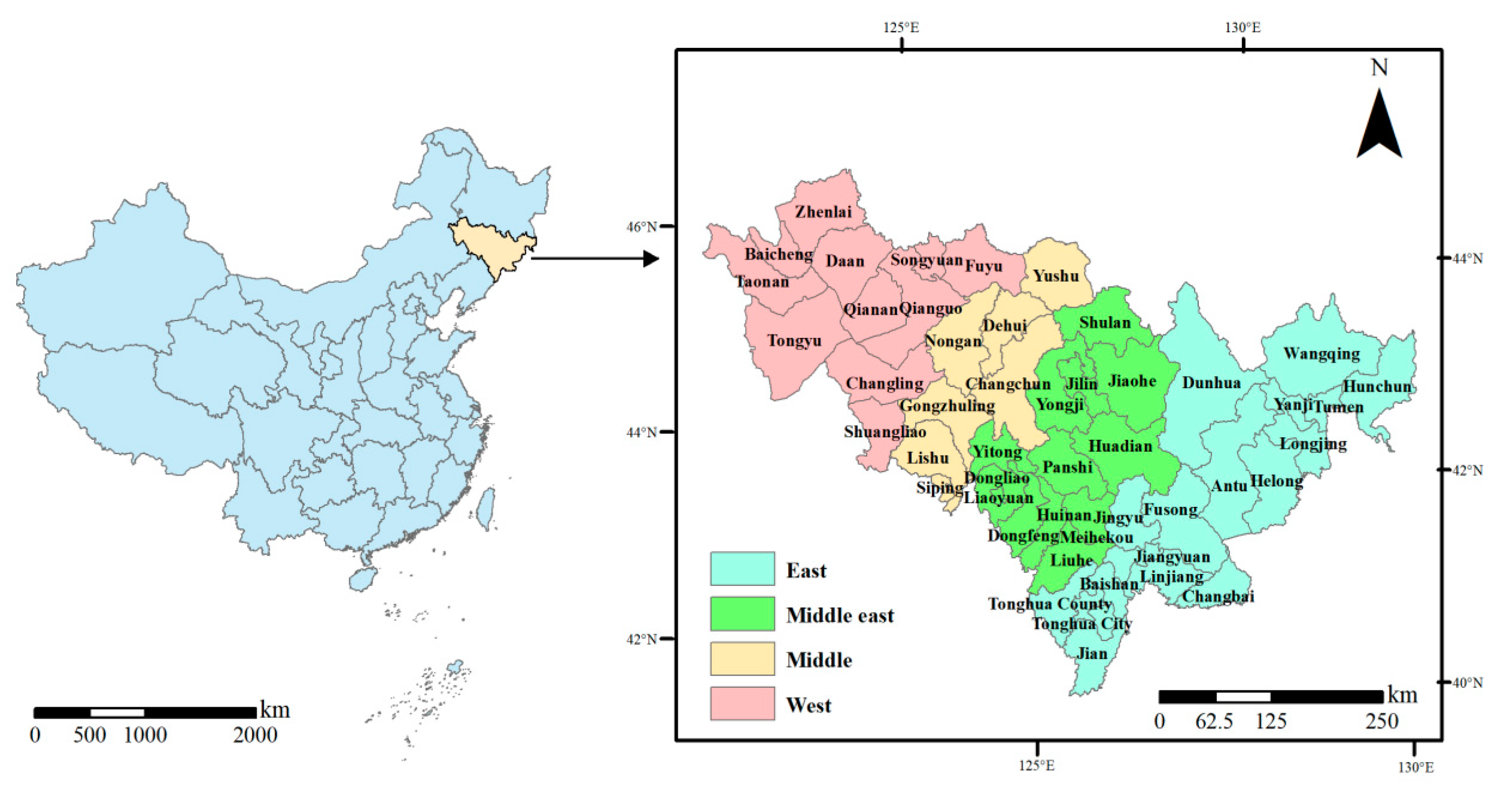
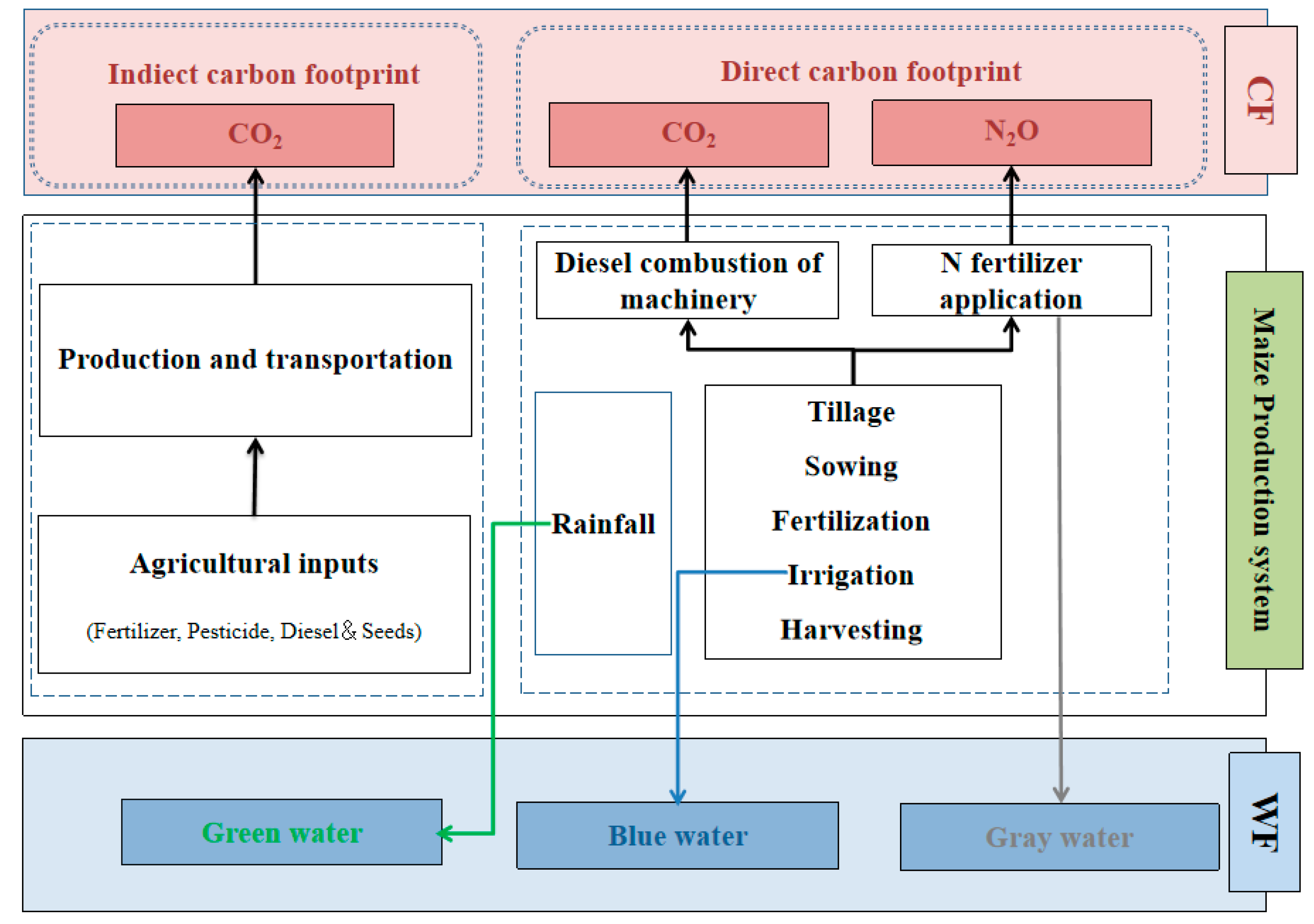
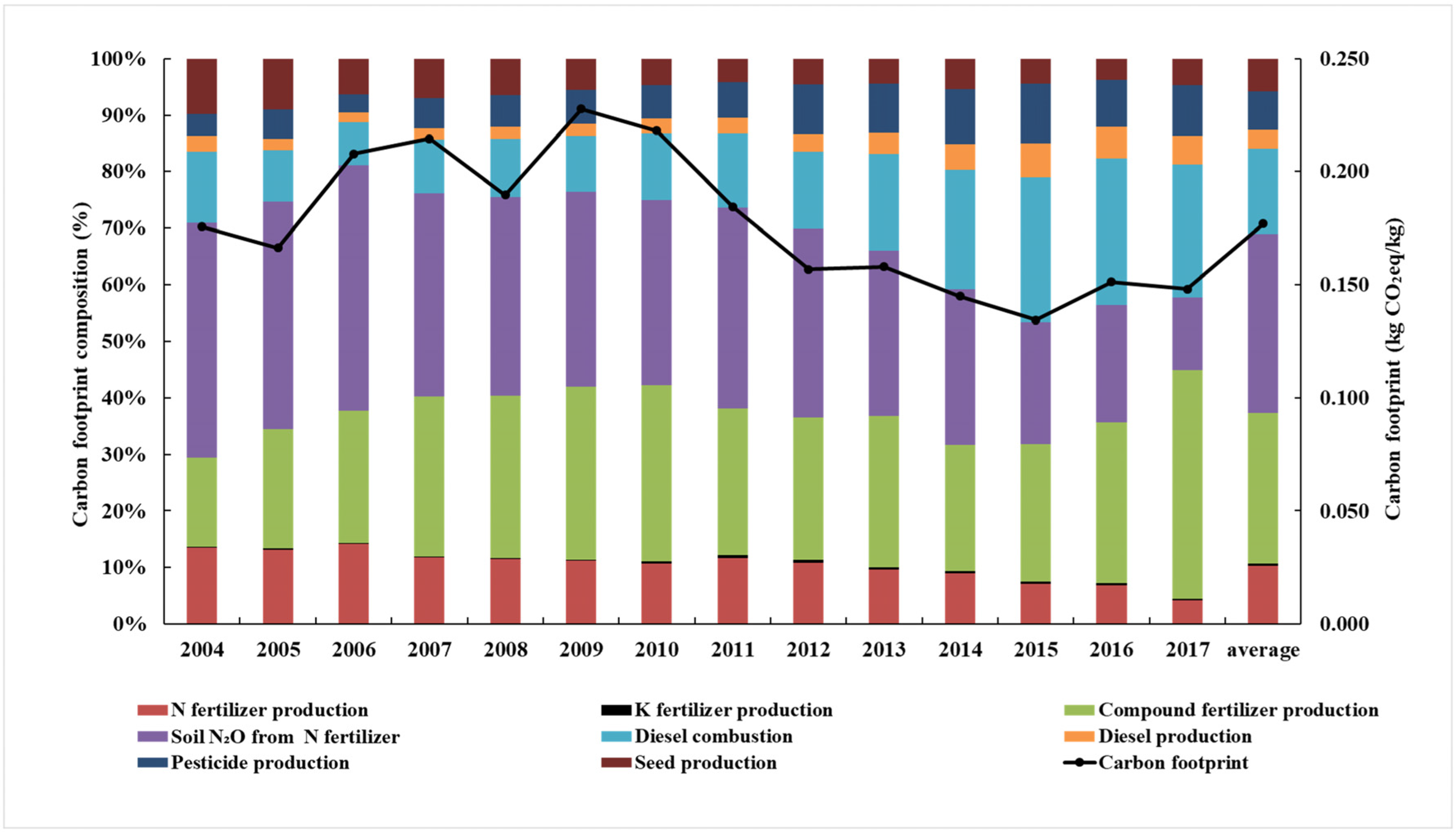
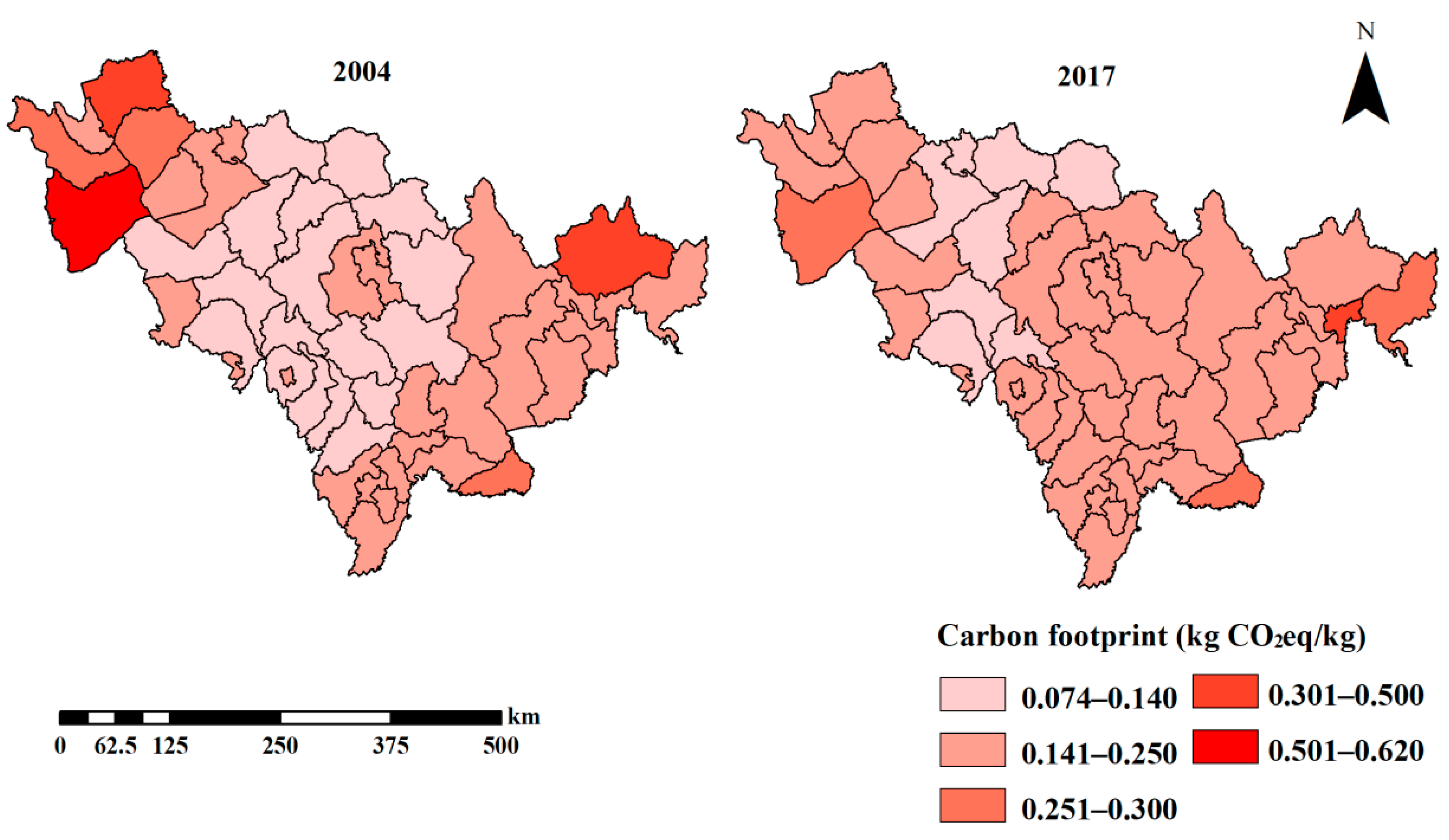
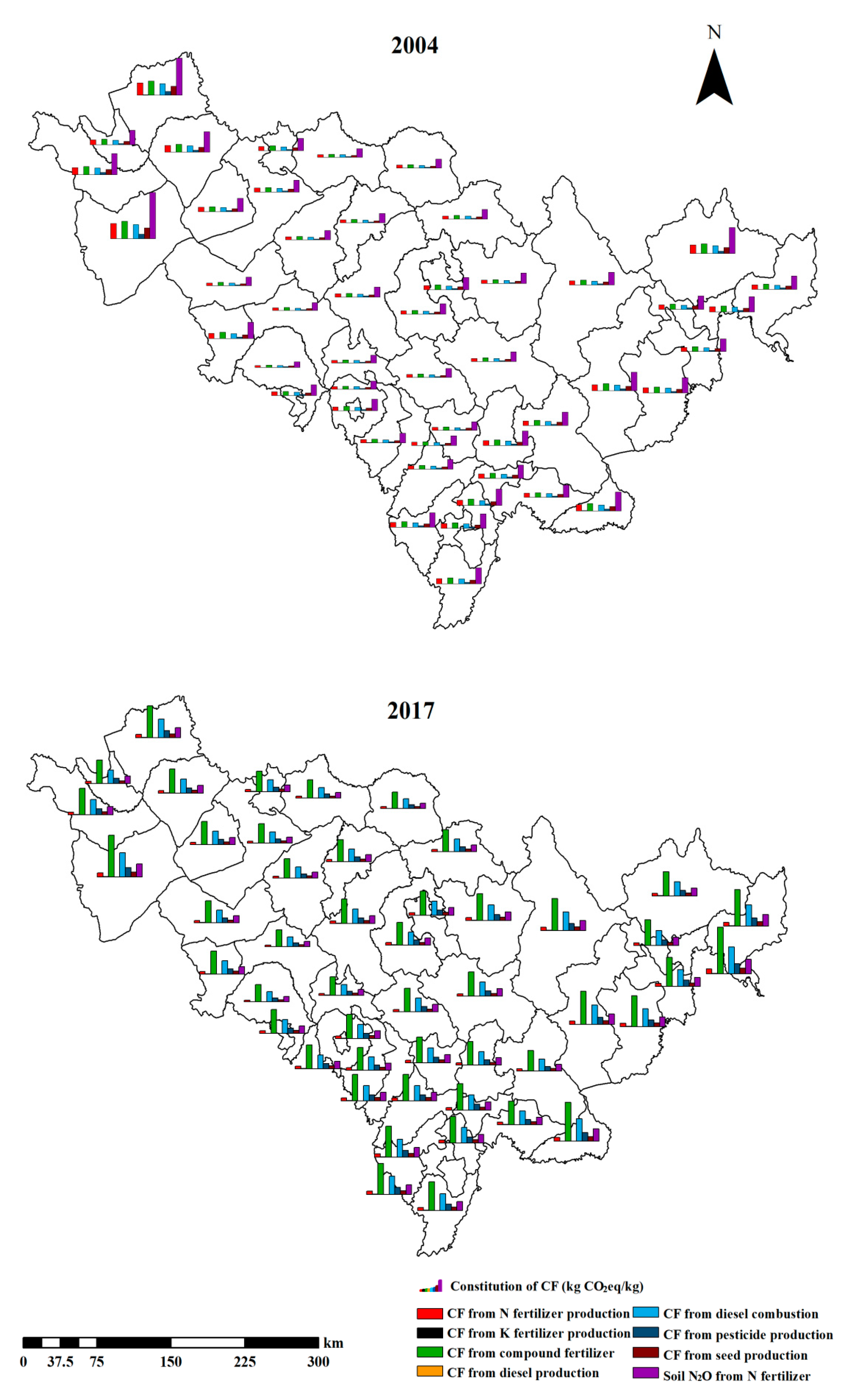
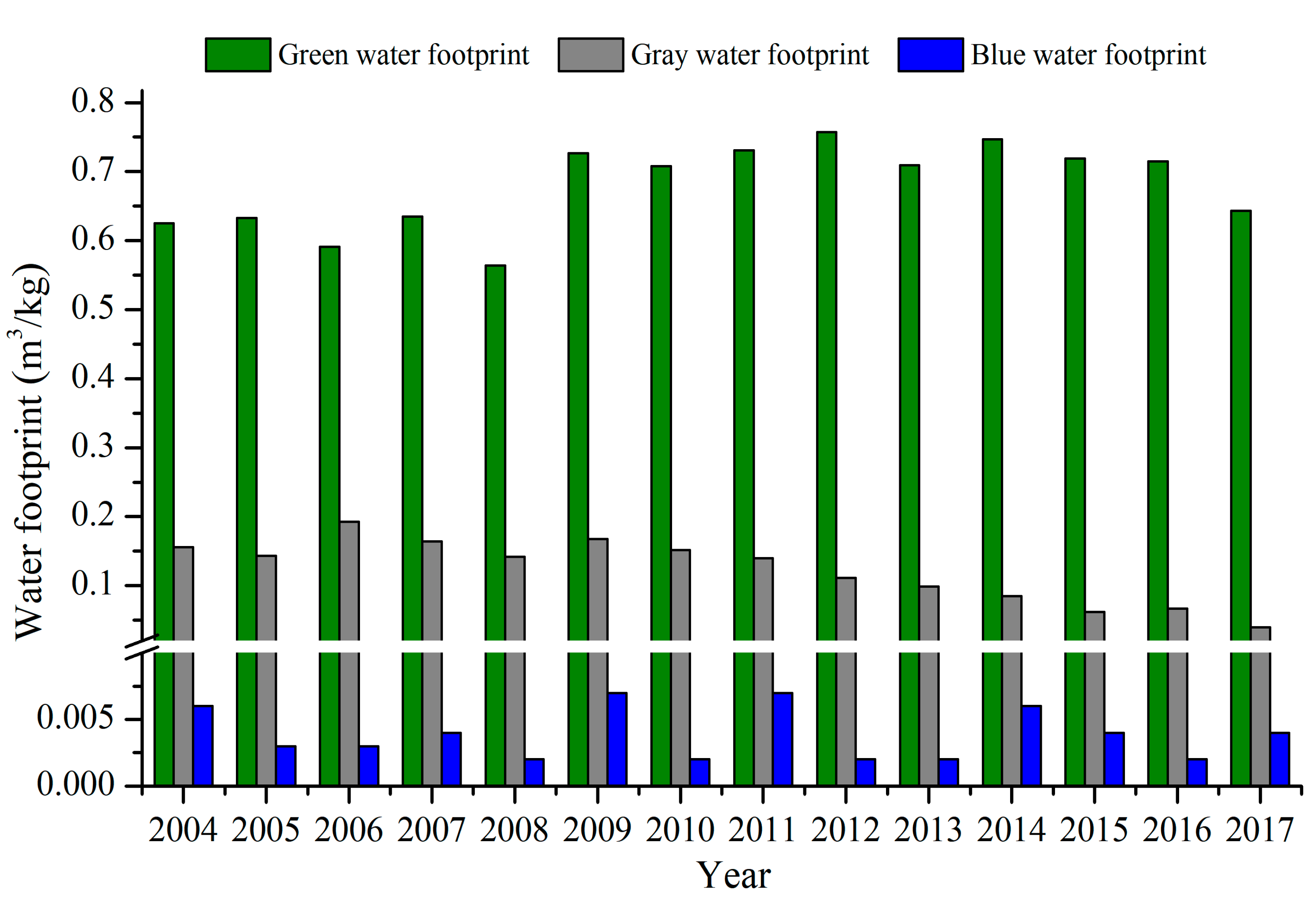
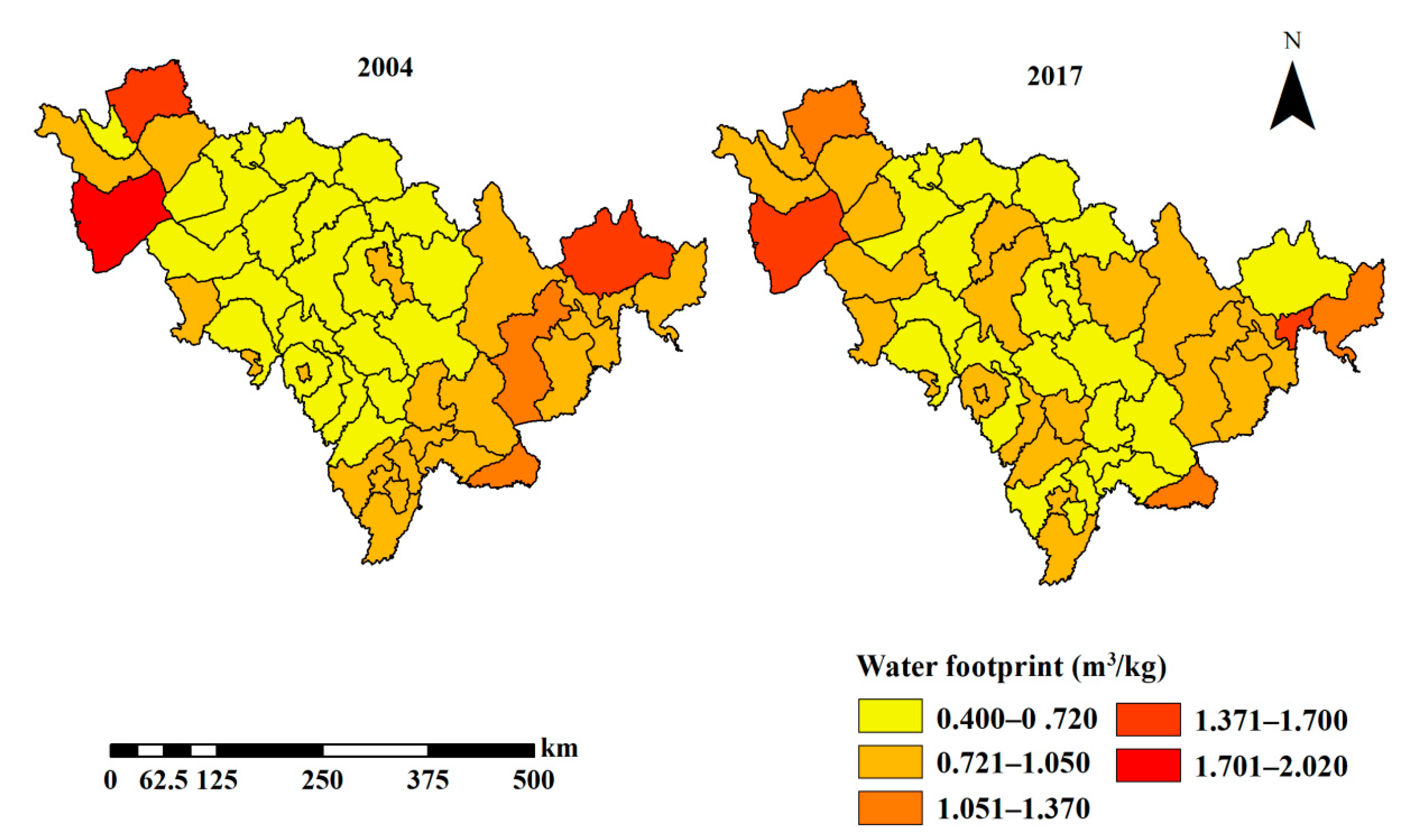
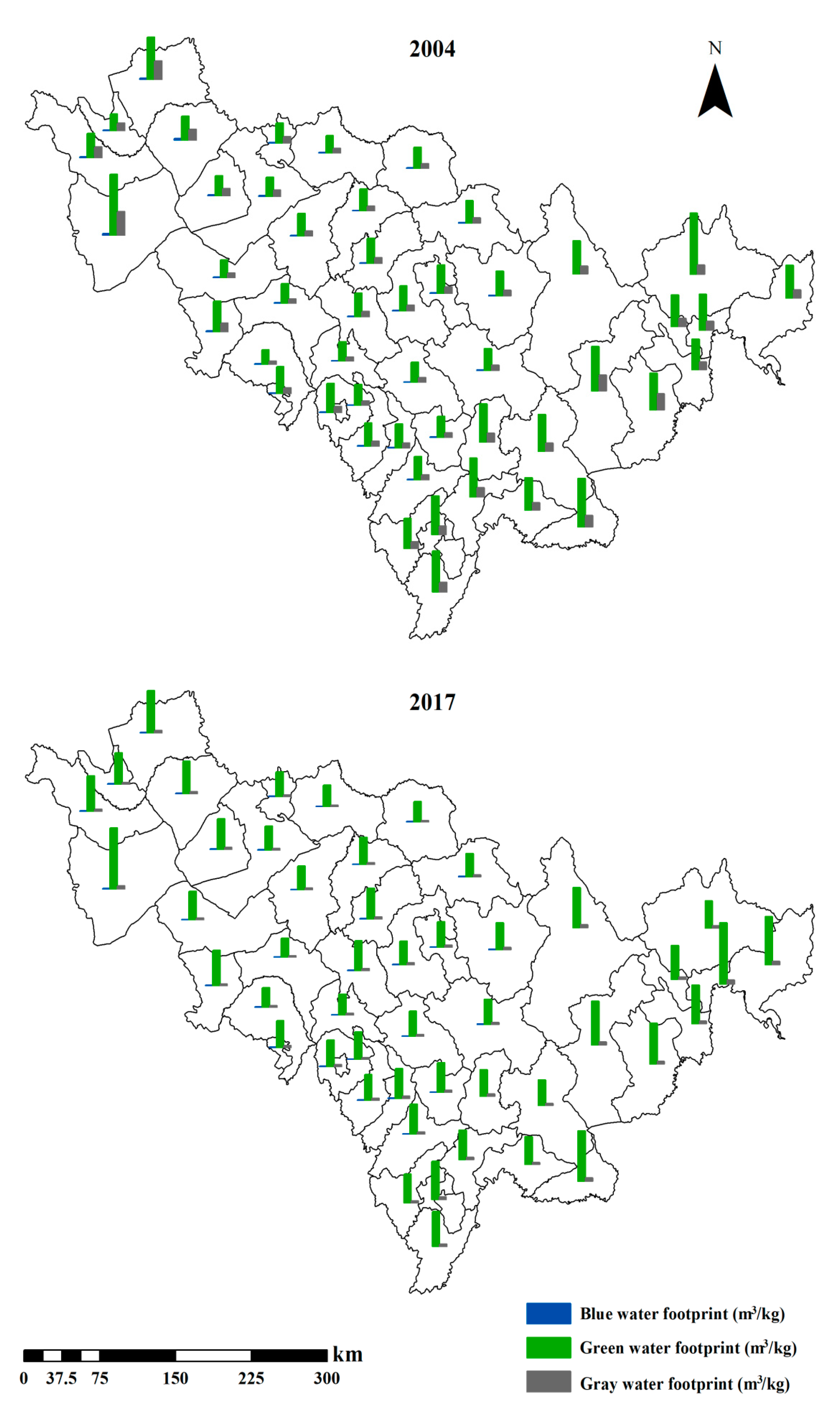
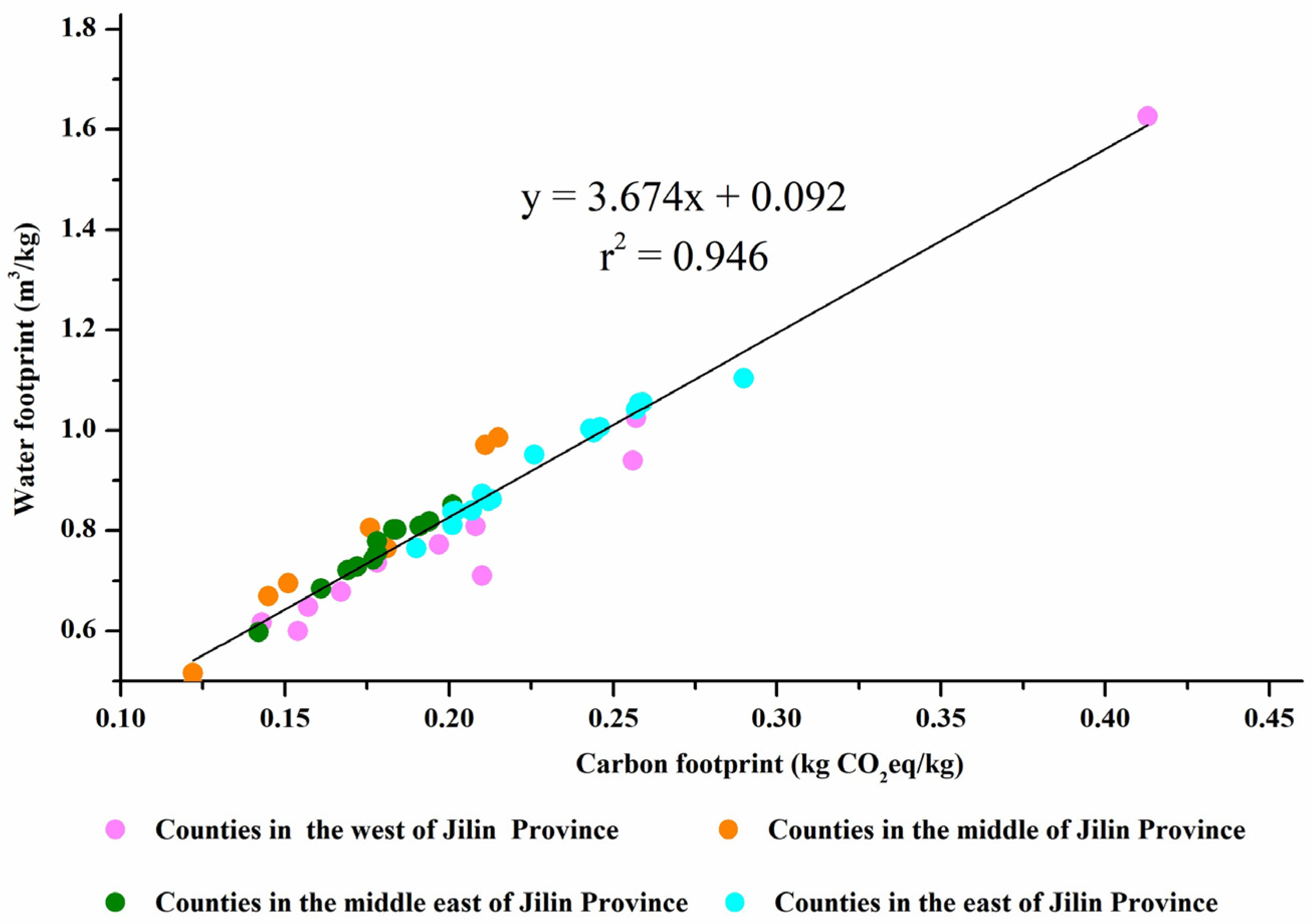
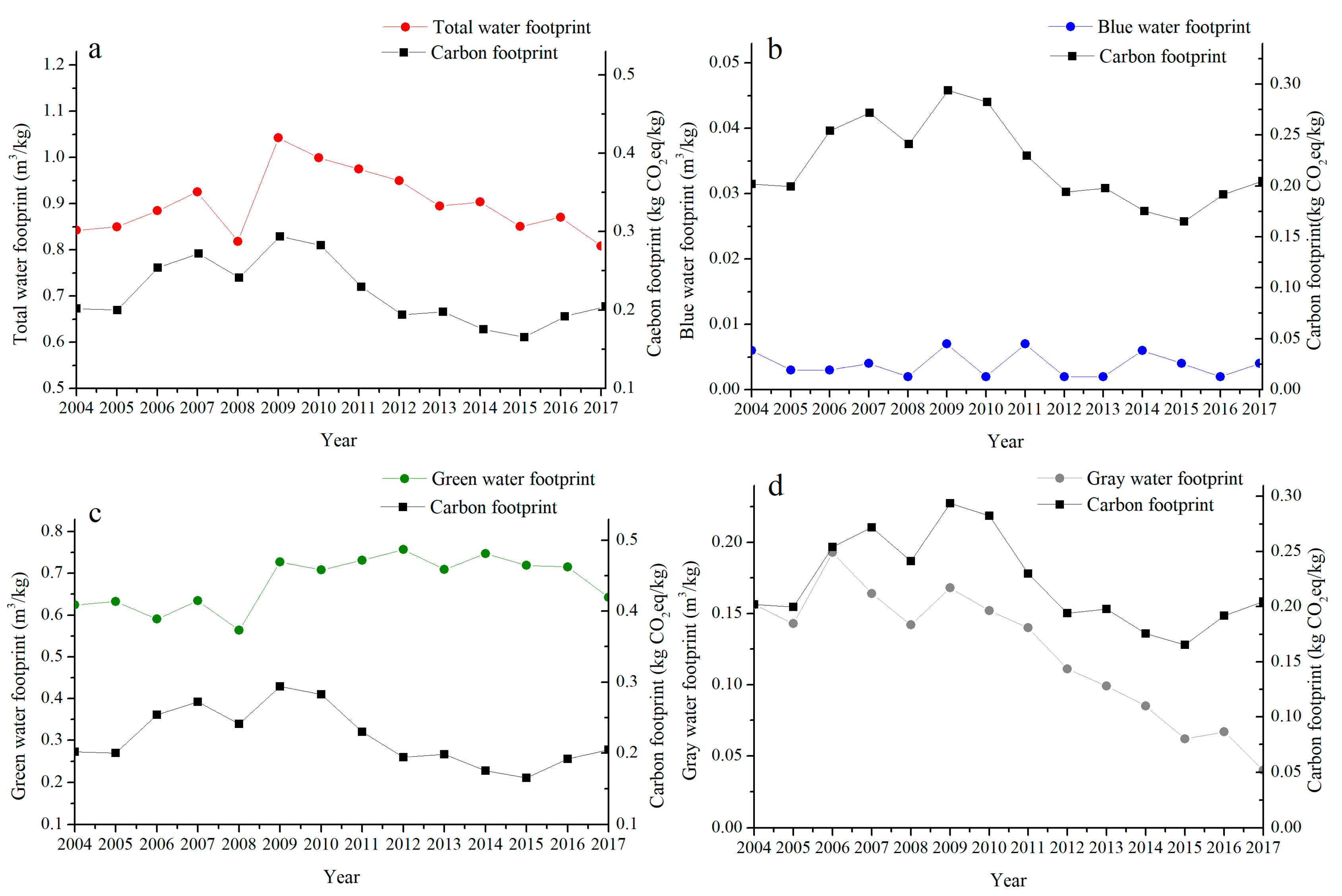
| Region | Landforms | Average Temperature (°C) | >10 °C Accumulated Temperature (°C) | Average Annual Precipitation (mm) |
|---|---|---|---|---|
| East | Mountains | 2.7–6.4 | 1900–2800 | 700–900 |
| Middle east | Low mountains and hills | 3.5–4.9 | 2700–2900 | 650–700 |
| Middle | Plains | 3.7–5.9 | 2900–3000 | 500–600 |
| West | Plains | 4.4–5.3 | 2900–3050 | 400–500 |
| East | Middle East | Middle | West | |
|---|---|---|---|---|
| Wet year | 0 | 20 | 30 | 40 |
| Normal year | 0 | 30 | 40 | 50 |
| Dry year | 0 | 50 | 60 | 70 |
| Emission Source | Emission Factor | Reference |
|---|---|---|
| N fertilizer | 1.53 kg CO2eq/kg | CLCD0.7 |
| K fertilizer | 0.65 kg CO2eq/kg | CLCD0.7 |
| Compound fertilizer | 1.77 kg CO2eq/kg | CLCD0.7 |
| Diesel fuel | 0.89 kg CO2eq/kg | CLCD0.7 |
| Diesel combustion | 4.10 kg CO2eq/kg | CLCD0.7 |
| Insecticide | 16.60 kg CO2eq/kg | CLCD0.7 |
| Bactericide | 10.57 kg CO2eq/kg | CLCD0.7 |
| Herbicide | 10.15 kg CO2eq/kg | CLCD0.7 |
| Seeds | 1.93 kg CO2eq/kg | Ecoinvent2.2 |
| N2O emissions from fields | 0.01 kg CO2eq/kg | IPCC |
Publisher’s Note: MDPI stays neutral with regard to jurisdictional claims in published maps and institutional affiliations. |
© 2020 by the authors. Licensee MDPI, Basel, Switzerland. This article is an open access article distributed under the terms and conditions of the Creative Commons Attribution (CC BY) license (http://creativecommons.org/licenses/by/4.0/).
Share and Cite
Jia, L.; Qin, L.; Zhang, H.; Wang, J.; Li, B.; Dang, Y. Spatiotemporal Characteristics of the Carbon and Water FootPrints of Maize Production in Jilin Province, China. Water 2021, 13, 17. https://doi.org/10.3390/w13010017
Jia L, Qin L, Zhang H, Wang J, Li B, Dang Y. Spatiotemporal Characteristics of the Carbon and Water FootPrints of Maize Production in Jilin Province, China. Water. 2021; 13(1):17. https://doi.org/10.3390/w13010017
Chicago/Turabian StyleJia, Li, Lijie Qin, Huiyun Zhang, Jianqin Wang, Bo Li, and Yongcai Dang. 2021. "Spatiotemporal Characteristics of the Carbon and Water FootPrints of Maize Production in Jilin Province, China" Water 13, no. 1: 17. https://doi.org/10.3390/w13010017
APA StyleJia, L., Qin, L., Zhang, H., Wang, J., Li, B., & Dang, Y. (2021). Spatiotemporal Characteristics of the Carbon and Water FootPrints of Maize Production in Jilin Province, China. Water, 13(1), 17. https://doi.org/10.3390/w13010017





